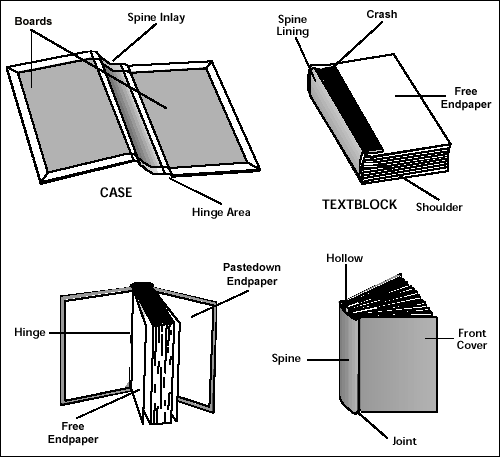|
Conservation
Book Construction
Before any attempts are made to repair
your Three Investigators books, a basic understanding of book construction
is needed. This page and the next concentrate solely on the case
bound Trade Hardcover Edition: how it's put together and how to repair
hinge damage (by far the most common repair).
In a Trade hardcover Three Investigators
book, the case, made up of the covers (boards with the illustrated
paper finish covering the front side of them), spine and spine inlay are
attached to the textblock via the crash and endpapers. The sequence:
the endpapers are cut in two at the middle to form the free and pastedown
sides. The free endpapers are glued to the shoulder of the first
and last page of the textblock. Next, the crash is glued to the spine
lining ("closed" side of the textblock) and a piece of flexible paper
is also glued to the underside of the crash to stiffen it. This assembly
is then placed into the covers and the pastedown endpapers are glued to
the front and back boards (hence the name pastedown), sandwiching the crash
between the board and the pastedown endpaper. The point at which
the crash, pastedown endpaper and spine lining meet is the hinge; this
is the point where all movement occurs and the first place to show damage.
If you read the above carefully,
you'll notice that the crash and spine inlay are not supposed to be attached
to each other. This creates a hollow space that allows the spine/spine
inlay to flex and the book to open more easily. Hardcover books that
have been incorrectly repaired lack this hollow space, making it difficult
to open the book completely; i.e. the binding feels stiff.
The following illustrates what was
described above:

The adhesive that book binders typically
use is a polyvinyl acetate (PVA). This was the type of adhesive used
on Trade hardcover Three Investigators books. PVA adhesives come
in a wide variety of types and grades, but in general they all require
no preparation, can be thinned and cleaned up with water, are very strong
and dry colorless/clear. Even with all of those benefits, some
PVA adhesives are better than others and unfortunately, Random House seems
to have chosen the poorer quality ones. This is evident in the vast
number of Trade hardcover titles that have cracked or separated cases only
25 years after they were printed.
First shown in Fundamentals, the following
is a re-listing of additional relevant terms in hardcover book construction:
Binding -- noun The
materials that hold a book together. There are two formats of bindings:
hardcover and paperback. Most modern hardcover books have a case
binding and most paperback books have a wrapped binding. | verb
Assembling a book.
Boards -- noun The
stiff cardboard on the front and back of a hardcover book that is covered
with leather, cloth or paper to form the covers.
Case
-- noun In a hardcover book, the combination of the covers, spine and spine
inlay.
Case Binding -- noun
A very common type of hardcover binding utilizing a case and textblock.
All Three Investigators hardcover books have a case binding.
Covers -- noun In a
hardcover book, the boards after they are covered with leather, cloth or
paper; referred to as the "front" and "back" covers. In a paperback
book, the one-piece heavy stock paper that wraps around the textblock to
create a front cover, back cover and spine.
Crash
-- noun The sturdy, open-weave cloth that extends onto and under
the pastedown endpapers to form the hinge and is glued to the spine lining.
It is typically reinforced with a thick piece of flexible paper along the
spine lining side. The crash is also referred to as the super.
Endpapers
-- noun The sheets of paper pasted to the inside of the front or
back cover (pastedown endpaper) and to the edge of the flyleaf (free endpaper).
Endpapers are used in hardcover books only.
Flyleaf -- noun A blank
page (or pages) inserted between the free endpaper and the beginning or
end of the printed pages.
Gathering -- noun A
folded printed sheet of pages prior to binding; referred to as a signature
after binding.
Hinge
-- noun The interior flexible area where the pastedown endpaper
meets the spine lining and crash; this is the inner equivalent of the joint.
Joint
-- noun The exterior flexible area where a board meets the spine;
this is the outer equivalent of the hinge.
Signature -- noun A
gathering bound with other signatures and trimmed.
Spine
-- noun The back portion of a book's binding; the portion which
is attached at the joints to the covers.
Spine
Inlay -- noun A stiff cardboard that forms the inner side of
the spine and sits below the crash. It is not glued to the crash
or spine lining.
Spine
lining -- noun The side of the textblock that faces the spine
and is attached to the crash.
Textblock
-- noun The completed and trimmed assembly of the signatures and
flyleaves, held together by glue or stitching. The side of the textblock
that faces the spine is called the spine lining.
Home << Previous | Next >> << Previous | Next >>
This page last updated on 02-Sep-03
|